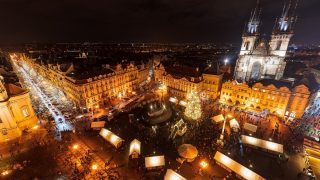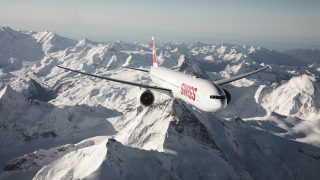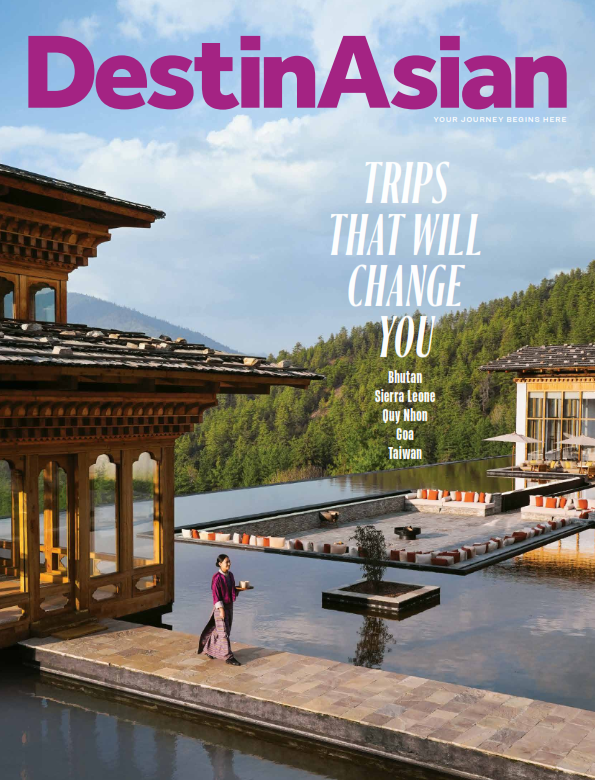Beneath the gaze of Switzerland’s most iconic mountain, Zermatt is a year-round alpine retreat, with ski slopes that remain open in the summer months, a wealth of hiking and mountain bike trails, and a charm that draws visitors back again and again.
“What is a stübli?”
Here in the southern Swiss canton of Valais, I suddenly recall a half-forgotten word from my childhood.
Magalie Perren ponders my question over a hearty four-course lunch at Restaurant Julen, a Zermatt institution that has been serving hungry patrons since 1910. “It’s like a cozy place, typically made of wood. Sometimes they also have food cooked on a grill. There’s one downstairs if you want to have a look.”
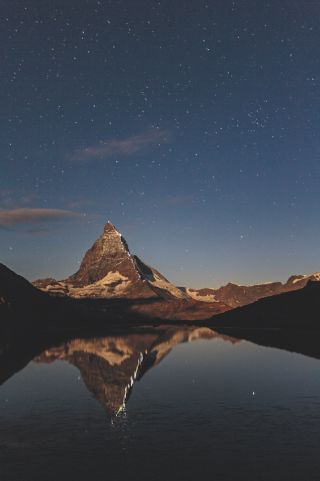
The Matterhorn reflected in the Riffelsee, an Alpine lake above Zermatt, at first light. Photo courtesy of Getty Images
I arrived in Zermatt just that morning after a 24-hour journey, and the familiar setting brought back memories of my very first trip to Europe some 16 years before. My German-speaking father—then employed at a Swiss multinational firm—took us hiking through meadows strewn with wildflowers, past ice-cold creeks dyed a milky aquamarine by the steady flow of glacial melt, to a placid lake high above the town. My older sister does not delight in walking long distances, but that day she was the first one down the mountain to reach the shops before they closed at 5 p.m. (it was a Sunday, after all).
In the decade and a half since I was last here, the town has seemingly mushroomed. Magalie tells me Zermatt now counts as many as 20,000 beds in its hotels and holiday apartments, compared to a year-round population of roughly 5,500. But it still retains the feel of a cozy mountain village, with traditional chalets and centuries-old log farmhouses roofed in flat, moon-gray slabs of slate piled atop one another in a rough diamond tessellation.
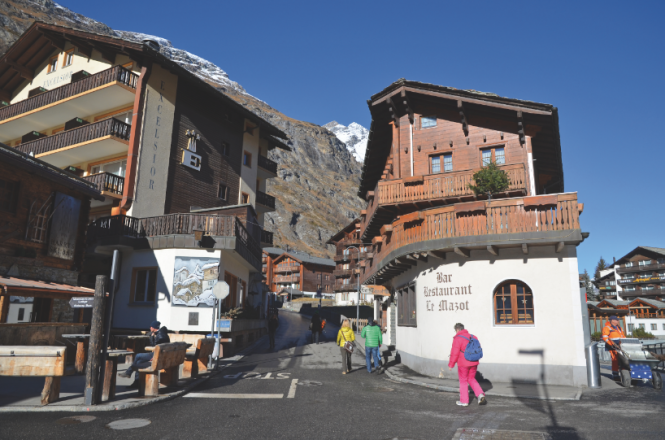
Cozy, wood-built family hotels and chalets welcome guests throughout the summer and winter. Photo by James Louie
What hasn’t changed is the watchful gaze of the pyramidal Matterhorn, a 4,478-meter-high peak that is more recognizable than any other Swiss summit. Though a significant portion lies in Italian territory, the mountain is a national icon whose image has no doubt been bolstered by the worldwide popularity of Toblerone.
It’s not an overstatement to say that Zermatt owes its current fortunes to the Matterhorn. In 1865, the successful (but tragic) first ascent of the peak, led by the Englishman Edward Whymper, would bring the Catholic German-speaking village immediate fame. That event led to a rush of alpinists and tourists that accelerated when the railway reached Zermatt in 1891.
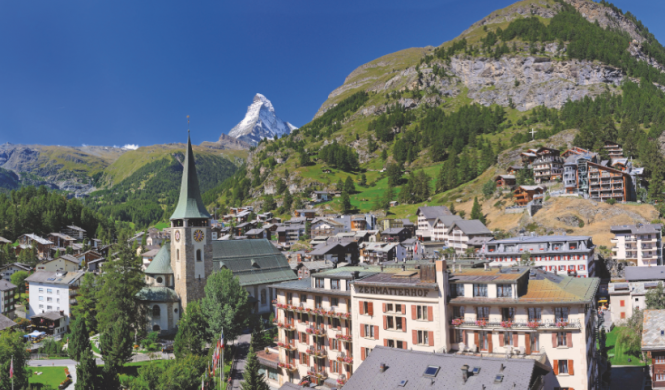
The car-free village of Zermatt lies just below Switzerland’s most famous peak. Photo courtesy of Zermatt Tourismus
Nowadays a good portion of the town’s residents are heavily involved in the tourism business. “My parents run their own hotel, and it was my grandfather who built it,” Magalie says. We had passed the building on the way to lunch, and she explained that Perren, her family name, is native to Zermatt.
At Restaurant Julen, I snack on thin slices of local rye bread known as roggenbrot, but it’s almost a mistake given the generous portions of the meal itself. First up is a delicate smoked salmon roulade flanked by salad drizzled in buttermilk dressing, followed by a delightful herbed cream soup. For my entrée, tender cuts of veal are served with baby potatoes and sautéed spinach. All this is washed down with a bottle of Zermatt Bier, produced in a local craft brewery that opened in 2015. By the time dessert arrives, I barely have any space left to polish it off.
Magalie and I walk off the calories on a stroll through town, starting at the old village center of Hinterdorf on the other side of the Vispa River. We can’t seem to go a couple of minutes before Magalie spots someone she knows, greeting passing acquaintances with a cheerful “ciao,” a word borrowed from nearby Italy. On the main street we stop twice for a casual conversation, first with an old friend who has just returned from the ski slopes, and then two gregarious workers from her parents’ hotel.
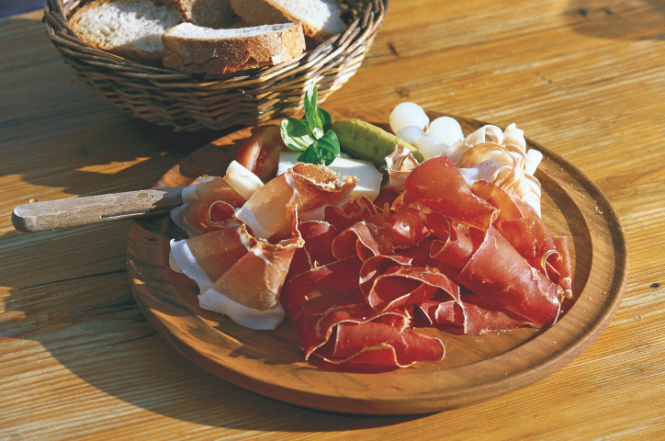
A traditional Valais platter featuring paper-thin slices of air-dried beef and cured ham. Photo courtesy of Getty Images
Magalie tells me that sort of familiarity also extends to repeat guests. “You get people who regularly come to Zermatt for 15, 16 years. They stay in the same room in the same hotel, and they get to know everyone who works there.”
The next morning, weighed down by a shiny pair of ski boots, I clamber aboard a cable car with Martin Hrejsa, an easygoing ski instructor with laughing green eyes and a stubbly beard. He asks me to call him Tinu. Our ride up is peppered with anecdotes and observations gleaned from his 16 years working in Zermatt. “The Russians, they expect to be pushed and they want to work very hard on the slopes. If they’re not tired at the end of the day, then you aren’t a good ski instructor … the Arabs, well, those who come from Kuwait and Abu Dhabi, the first thing they do when they arrive is pick up a handful of snow to taste it.” There are clients who book ski sessions the same week every year, much like Magalie’s words the day before.
Tinu and I are heading to the Theodul Glacier, the same area where my father once skied as a young man. High above the snowbound scenery, I look out from the cable car with a mixture of excitement and faint trepidation. It’s a perfect morning for carving the slopes: there isn’t a cloud in the sky and the pistes are not yet crowded. Italy, I’m told, lies just over the mountaintop.
“Welcome to my office,” Tinu quips. “It’s a bit small … and cold.”
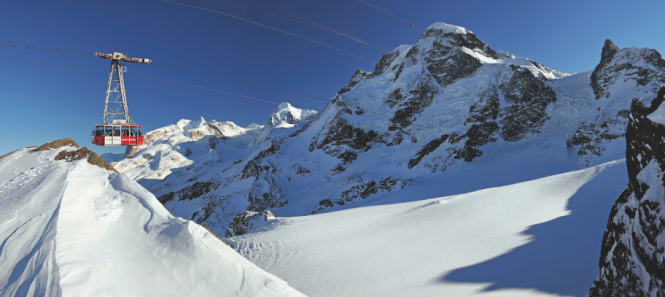
Gondolas ferry skiers to the Matterhorn Glacier Paradise. Photo courtesy of Zermatt Tourismus
Outside, the snowfall is roughly a week old, with innumerable specks of ice crystals shimmering in the sunlight like diamonds. I can see Zermatt far below in the shadows of the valley, a haphazard mass of houses and hotels straddling both banks of the river. Directly to the west, the Matterhorn rises above us in its full, Toblerone-esque glory.
I wonder if Tinu can sense my underlying apprehension. The last and only time I ever tried skiing was in Japan at the age of 13; whatever I had learned in the course of that week was quickly forgotten once my family returned to the subtropical climes of Hong Kong.
But Tinu is optimistic. “I think you’ll still remember. It’s in there, in your subconscious,” he reassures me. “Skiing is like learning to walk or bike—you never forget.”
Once clipped in, I’m surprised at how quickly I recall the basics. The experience is a far cry from that first run in Hokkaido, when my brother and I were simply brought to the top of a beginner’s slope with the expectation that we knew how to slow down and stop. Of course, it isn’t all smooth sailing. Turning too much and too soon at one point brings me to a sudden halt; I feel my right ski boot popping out of the bindings, but the fall is painless and recovery is quick. After a coffee break to rest our legs and a refresher on parallel turns, Tinu suggests the unthinkable. “Now I will show you the racing position.”
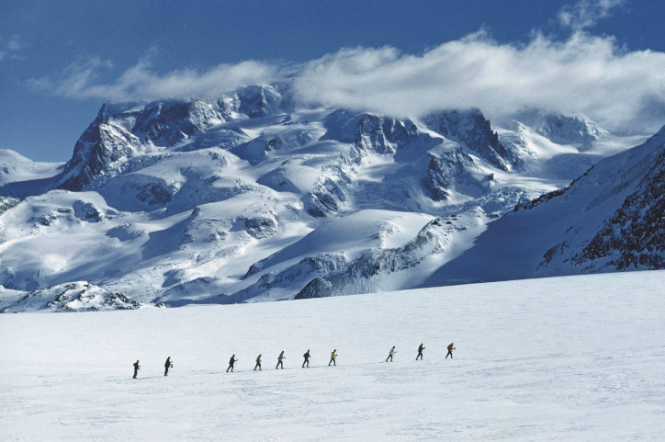
Trekkers crossing the Theodul Glacier, with Monte Rosa in the background. Photo courtesy of Getty Images
It’s easier than it sounds. We crouch low to the ground in a near-horizontal position, with elbows on knees and ski poles up in the air. Whizzing down the piste is thrilling but strangely meditative, thanks to the sound of the wind rushing past. A grinning Tinu waits at the end, and once I catch up with him he goes in for a high-five. “You’ve met Mr. Speed!”
Before I know it, the three-hour session is almost over. “You should come back in the summer,” Tinu says. “We can go skiing in the morning, have a picnic lunch, then bike all the way back to town in the afternoon.” The two of us exchange contact details before parting ways, and as I observe the valley from a descending cable car, I can’t shake the feeling that Zermatt is a metaphorical stübli: a cozy, welcoming environment with plenty of comfort food to boot. I won’t wait another 16 years to return.
Getting There
Zermatt is a car-free town, so anyone making the journey by road should park at the Matterhorn Terminal in Täsch before hopping aboard a shuttle train or electric taxi. Zurich is just over three hours away by train, with one change in nearby Visp.
Where to Stay
Equipped with a cozy spa, the rustic Hotel Berghof (41-27/966-6900; doubles from US$258) stands at the upper end of Zermatt, steps from a cable car station which offers easy access to a vast network of hiking trails and ski slopes. Here, Italian-accented multi-course dinners make for a satisfying end to a day spent outdoors. In the center of town, the plush, 41-room Hotel Monte Rosa (41-27/966-0333; doubles from US$340) is Zermatt’s oldest lodgings. Its previous incarnation hosted Edward Whymper’s mountaineering party as they set out for the first ascent of the Matterhorn.
This article originally appeared in the April/May 2017 print issue of DestinAsian magazine (“Altitude Check”).

